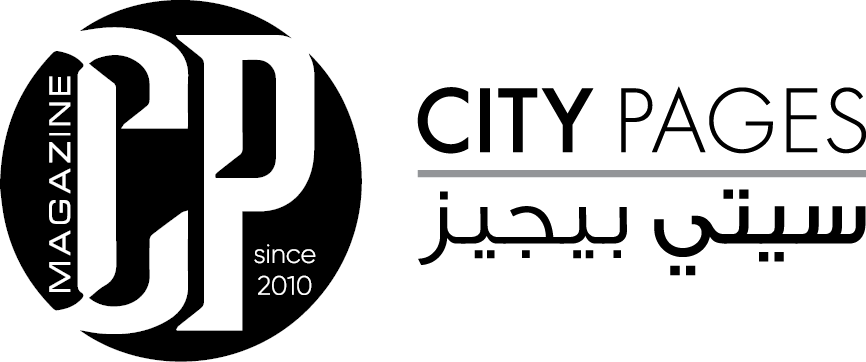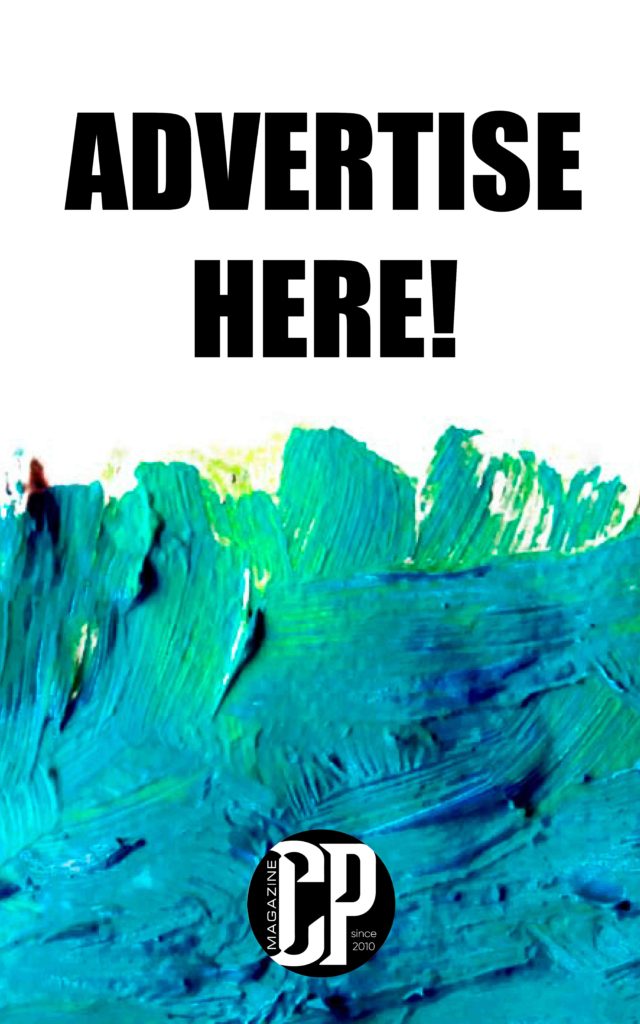At the iconic W Dubai Mina Seyahi hotel in the United Arab Emirates, Argentine artist and creative director Pilar Zeta presented her latest works in an exhibition curated exclusively for W Hotels in collaboration with Mambo Creatives, coinciding with the 17th edition of Art Dubai. Renowned for its striking architecture and fusion of modern design with Middle Eastern allure, W Dubai Mina Seyahi provided an ideal backdrop for Zeta’s creations. The hotel, esteemed as a cultural hub for discerning travelers, not only prioritizes vibrant energy but also champions the showcasing of diverse talents such as Zeta. The exhibition, situated on the ground floor within the hotel’s secluded garden, featured sculptures and intricately woven carpets inspired by traditional chessboard motifs, captivating visitors and fostering a gathering space for art enthusiasts.

THE INSTALLATION
Debuting The Garden of Duality, Pilar Zeta engages with the fusion of strategic philosophy and artistic expression, unveiling a captivating exploration. At its core stands a commanding sculpture of the king shaped like a portal – a conduit bridging realms of light and darkness. This intricate piece beckons reflection on the profound nature of the eternal spirit, setting the stage for a nuanced exploration through the chessboard’s symbolism.
The collection also features a hyper-realistic oil painting depicting the intricate details of the chess pieces – a testament to the profound philosophy embedded in each strategic move. A delicately woven tapestry illuminates the philosophical constitution of man, guided by insightful words echoing esoteric symbolism ‘the kings represent the spirit; the queens the mind; the bishops the emotions; the knights the vitality; the castles, or rooks, the physical body.’

Within The Garden of Duality, the chessboard emerges as a symbol of duality – a space where opposing forces harmonize in a delicate dance of strategy. Adorned with postmodern-style sculptures in resin and metal, the board introduces an additional layer to the narrative, seamlessly merging light, and darkness. Embark on this immersive exploration where the chessboard’s mysteries invite connoisseurs to contemplate the essence of light and darkness, strategy, and art in the human spirit.
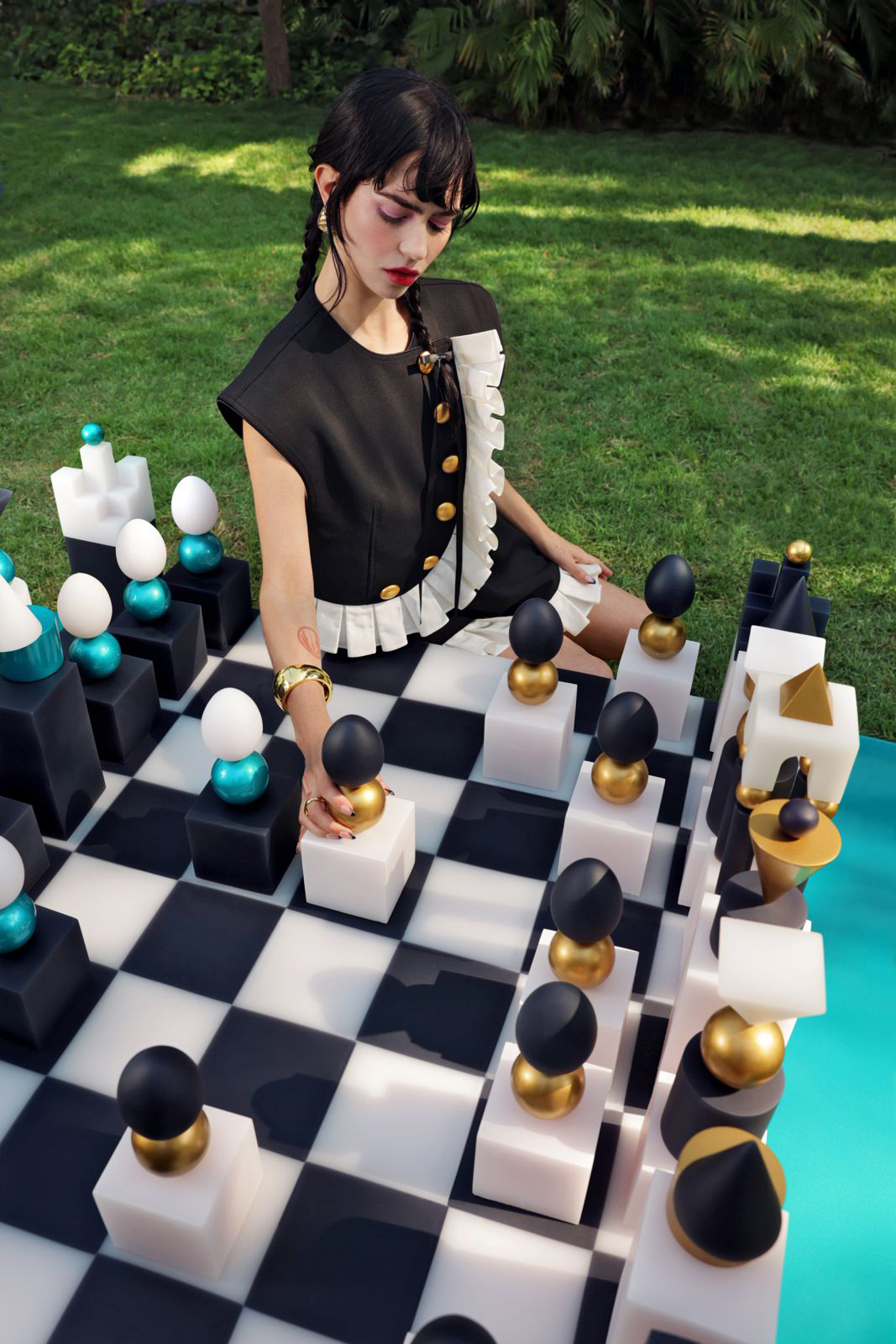
Dina joins José Berrocoso, our lifestyle editor, for an in-depth exploration of the narrative behind her artistic journey and the inspiration that fuels her creativity.
Can you tell us about the inspiration behind your art installation at W Dubai Mina Seyahi as part of Art Dubai?
The core inspiration for my art installation, “The Garden of Duality,” revolves around the symbolism of the chessboard. I aimed to delve into the profound nature of duality inherent in the game, where opposing forces harmonize in a delicate dance of strategy. Through a commanding sculpture of a king-shaped portal, hyperrealistic oil painting, delicate tapestry, and postmodern-style sculptures, I explore the chessboard as a space where light and darkness merges. Embarking on this immersive journey invites contemplation of the essence of strategy, art, and the human spirit, all encapsulated within the symbolic landscape of the chessboard.
How does your artwork interact with the overall aesthetic and atmosphere of W Dubai Mina Seyahi?
This artwork seamlessly integrates with the modern, futuristic ambiance of Dubai. Through its commanding presence and intricate symbolism, the installation adds depth and contemplation to the space, inviting guests to engage with the fusion of strategic philosophy and artistic expression within the dynamic landscape of Dubai.
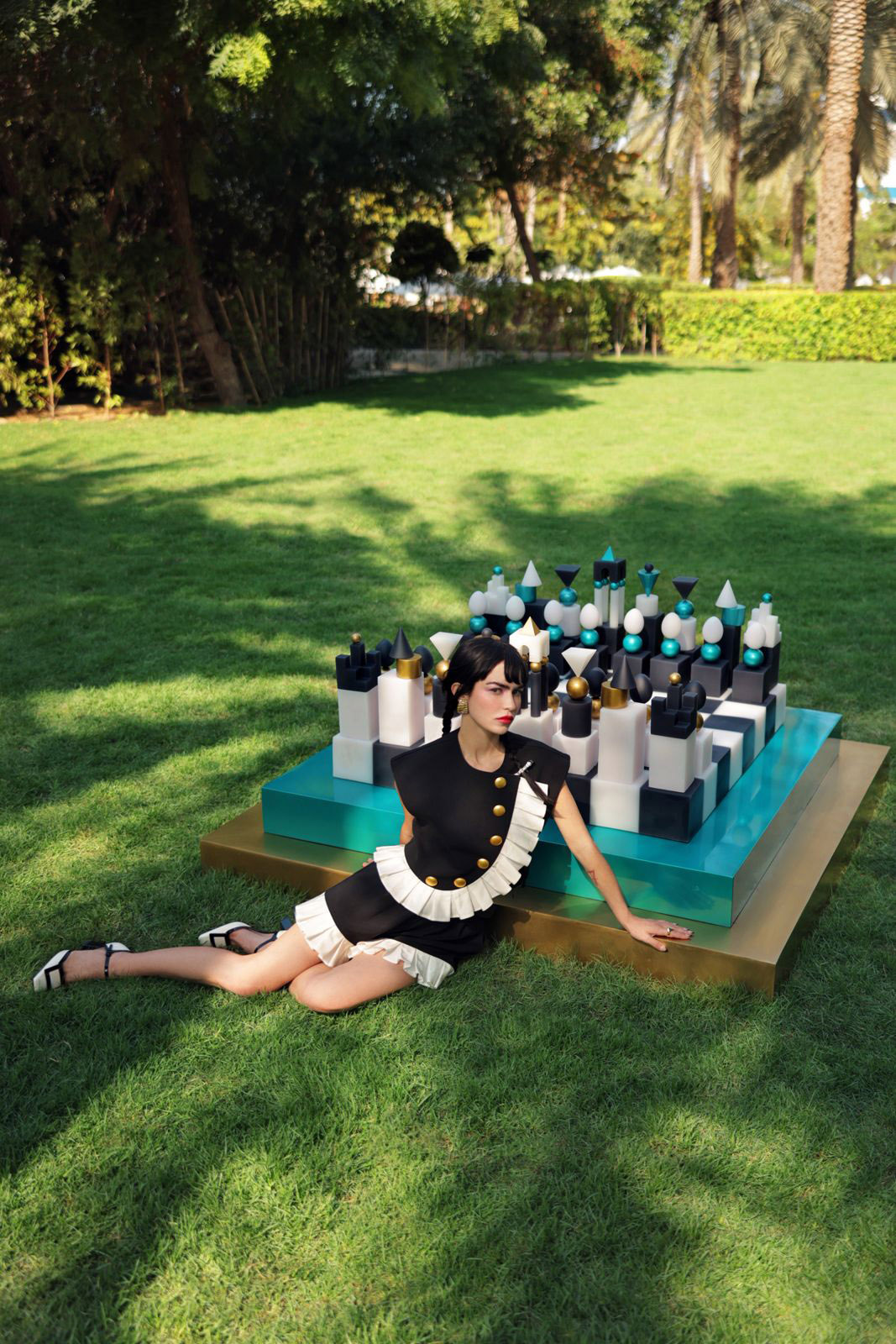
Were there any specific elements of Dubai or the Middle East or the hotel’s environment that influenced your creative process?
The colorful landscape of Dubai, influenced by the Middle East, and the modern atmosphere were key inspirations. Infusing elements of blue and gold into “The Garden of Duality,” I aimed to capture the city’s vibrancy while exploring strategic philosophy and artistic expression within a contemporary context.
What emotions or experiences do you hope to evoke in viewers through your installation?
Through my installation, the aim is to evoke introspection by highlighting how chess symbolizes life’s challenges. By immersing viewers in a world where strategy and art converge, I hope to spark curiosity about the parallels between chess moves and life decisions. Ultimately, the goal is to encourage reflection on the interplay between light and darkness, strategy and art, within the fabric of existence.
Can you share some insights into the materials and techniques you used for this particular project?
For this project, my intention was to explore the concept of chess through various mediums, including an oil hyperrealistic painting, a Persian-style handmade rug, a large metal sculpture, and a postmodern-style chess set crafted with car paint metal and resin.
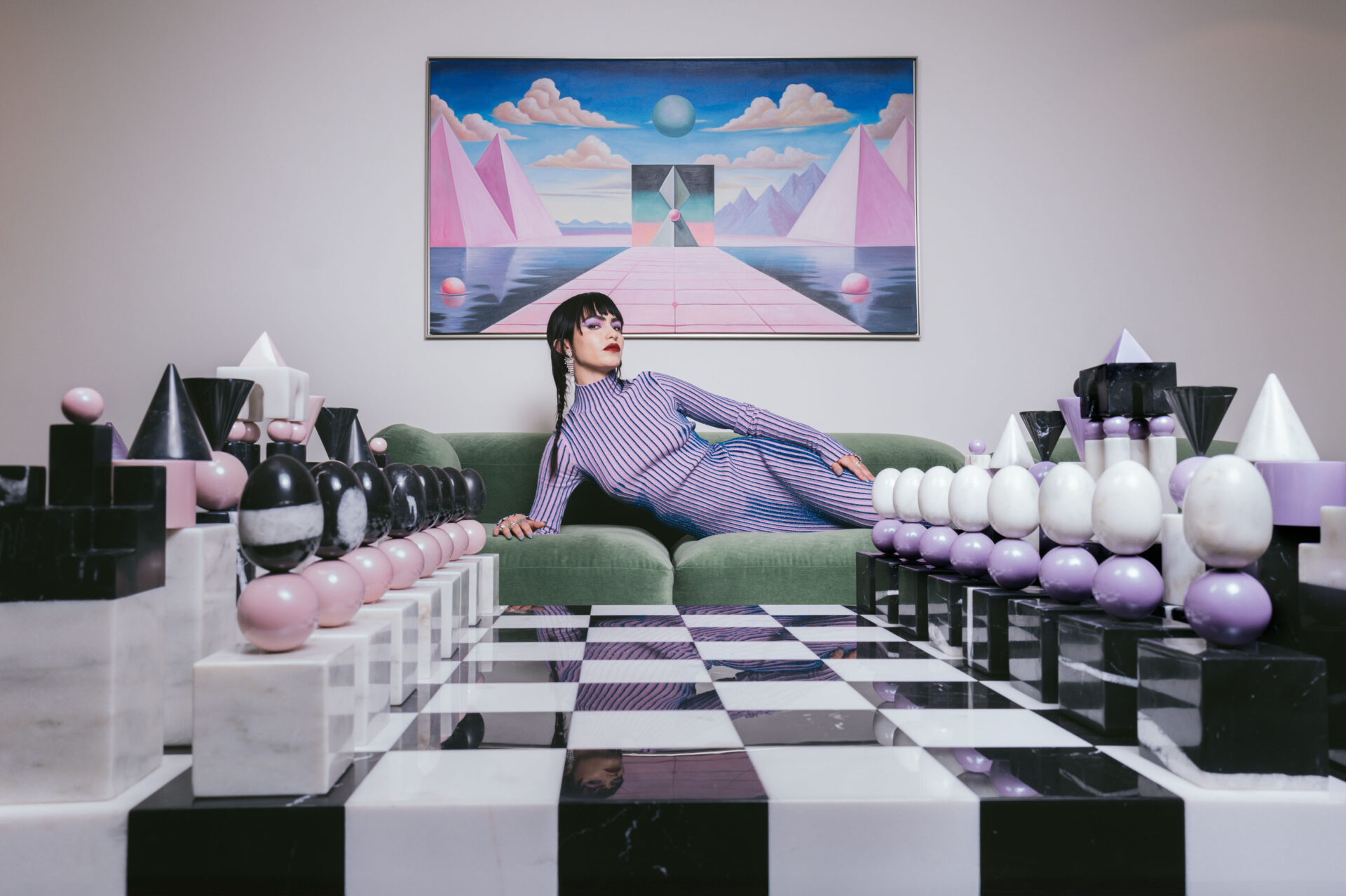
Your installation at W Dubai Mina Seyahi features large-scale sculptures, a chess concept, and a hyperrealistic tapestry. Could you elaborate on the immersive experience of the chess piece, particularly how traditional pieces undergo a mesmerizing transformation into abstract sculptures that challenge the game’s structure?
Within the installation at the hotel, the large-scale sculptures offer an immersive experience where traditional chess pieces undergo a captivating transformation into abstract forms. These sculptures challenge the conventional structure of the game, inviting viewers to explore the intersection of art and strategy in a visually mesmerizing way. The abstract nature of the sculptures adds depth to the chess concept, providing a unique perspective on the dynamics and complexities of the game.
Additionally, how does the game board, with its vibrant colors and intersecting lines, symbolize the shifting landscapes of the postmodern era?
The vibrant colours and intersecting lines of the game board symbolize the shifting landscapes of the postmodern era by echoing the principles of postmodern architecture. Postmodern architecture often employs bold geometric shapes and vibrant colors to break constraints and challenge traditional design norms. Similarly, the game board reflects this ethos by using dynamic geometry and color to create an immersive experience that mirrors the fluidity and complexity of contemporary society.

Your work, “Mirror Gate”, extremely popular in the GCC, reflected a deep fascination with the Pyramids of Giza and ancient Egyptian culture. How did the mysticism and enigma surrounding the Egyptian culture influence the creation of this limestone portal, adorned with gold and iridescent blue spheres?
Drawing from my lifelong fascination with Egyptian mythology and the enigma surrounding the pyramids, “Mirror Gate” at Forever is Now 2023 encapsulates this enduring obsession. Crafted from limestone akin to the pyramids and adorned with gold and iridescent blue spheres, the installation symbolizes ancient Egypt’s mystique and legacy. Its checkerboard pathway, reminiscent of Egyptian games, leads to a mirror egg sculpture, echoing creation myths and inviting introspection. “Mirror Gate” serves as a testament to my ongoing exploration of Egyptian mysticism, offering viewers an immersive experience that bridges ancient symbolism with contemporary consciousness.
Could you share more about the symbolic significance of the checkerboard pathway leading to the mirrored egg on a plinth under the pyramidal apex?
The egg within “Mirror Gate” serves as a profound symbol of creation, echoing ancient Egyptian mythology where it represents birth, growth, and the essence of all creation. As visitors encounter this mirrored egg, they are prompted to reflect deeply on their own journey through life and the cyclical nature of existence.
Moreover, the reflection between the pyramid and ourselves acts as a portal, facilitating a transcendental experience that transports us into a new dimension of consciousness. Through this reflection, we are drawn into a realm where the boundaries between past and present, material and spiritual, blur, allowing for profound introspection and connection with the eternal essence of humanity.

How does your artistic style and approach evolve when creating for an open space as opposed to a traditional gallery space?
The energy of a space can profoundly influence our perception of art, shaping our emotional and cognitive responses to the artwork. In open spaces, the dynamic interplay between the artwork and its surroundings can evoke different sensations and interpretations. The energy of the space, whether it’s bustling with activity or imbued with serenity, can enhance or alter our engagement with the artwork. Additionally, factors such as lighting, acoustics, and architectural elements contribute to the overall atmosphere, affecting how we experience and interpret the art. Ultimately, the energy of the space acts as a catalyst, amplifying the impact of the artwork and enriching our understanding and appreciation of its significance.
In what ways does the audience’s interaction with your installation play a role in the overall experience?
The audience’s interaction with my installation is integral to the overall experience, as it prompts introspection and self-discovery. My aim is for my art to serve as a reflection for individuals, inviting them to delve deeper into their own identities and experiences. Through interaction, viewers may uncover new insights, leading to moments of transcendence and self-realization. This dynamic exchange fosters profound connections and enriches the overall artistic experience.

Can you share any memorable moments or anecdotes from the process of bringing your vision to life at your new installation at Art Dubai?
Excited to finally bring my work to Dubai for Art Dubai, a city that’s always been on my bucket list. One memorable moment during the process was the anticipation of visitors enjoying my art and seeing their responses.
As a creative person, how do you balance artistic vision with practical considerations and client expectations?
As a creative, I approach the balance of artistic vision, practical considerations, and client expectations through collaborative flow. I thrive on bringing ideas from a deeper creative plane, channeling them during moments of flow. Remaining open to the unknown, I embrace the excitement of the process, ensuring that each project is an exploration where innovation and practicality intertwine harmoniously.
Can you share insights into maintaining a work-life balance in a demanding creative field?
Maintaining work-life balance in a demanding creative field is crucial. I prioritize self-care and set clear boundaries to prevent burnout. Daily meditation keeps me centered and positive, helping me embrace challenges with resilience. Additionally, I prioritize learning, research, and staying inspired, which fuel my creativity and passion for innovation.
What’s your personal motto?
My personal motto is to keep myself inspired, always give back positivity to the universe with my art, and create no matter what.

What motivates you? Is it money, fun, life or something else?
What motivates me is the act of creating artwork and staying in a state of flow, vibrating high with creativity and inspiration.
Are there any future projects or collaborations you’re excited about?
Yes, I’m thrilled to be collaborating with the Moco Museum on a large-scale sculpture project. I adore their work and am incredibly excited for the world to see what we’re creating together.
What’s next for Pilar Zeta?
My dream would be to visit portals around the world, especially in sacred places with energetic vortexes like Easter Island or the Alula Desert. I like the idea of blending the ancient and the future, which is why visiting the Pyramids of Giza, an ancient and enigmatic site where they may have had more advanced technology than our current, was a dream come true for me.
If you could have one superpower, what would it be?
Teleportation.
